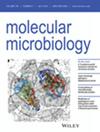Defining the Enterococcus faecalis Fatty Acid Kinase System of Exogeneous Fatty Acid Utilization
IF 2.6
2区 生物学
Q3 BIOCHEMISTRY & MOLECULAR BIOLOGY
引用次数: 0
Abstract
Phospholipid synthesis in Firmicute bacteria differs markedly from that of the paradigm确定粪肠球菌脂肪酸激酶系统的外源性脂肪酸利用
厚壁菌的磷脂合成与典型的大肠杆菌途径明显不同,因为酰基磷酸盐是一个关键的中间体。酰基磷酸盐是由PlsY酰基转移酶催化的磷脂合成途径的第一个酰化步骤所必需的,并且通过两种不同的途径合成。在缺乏外源脂肪酸的情况下,新合成的酰基-酰基载体蛋白(ACP)物种被PlsX酰基- ACP:磷酸酰基转移酶转化为酰基磷酸盐,该酶将酰基链从ACP转移到无机磷酸盐。当外源脂肪酸存在时,这些酸通过FakAB脂肪酸激酶转化为酰基磷酸,并可通过PlsX转化为酰基ACPs。活性激酶由ATP -需要FakA亚基和FakB脂肪酸结合蛋白组成,FakB脂肪酸结合蛋白的作用是将脂肪酸羧基呈递给FakA激酶活性位点。在迄今为止检测的所有厚壁菌门中,存在多种FakB物种。金黄色葡萄球菌有两个,而肺炎链球菌有三个,而粪肠球菌编码四个FakB蛋白。我们报告了这些蛋白质的脂肪酸偏好,这些蛋白质是通过使用缺乏每个FakB或三个FakB缺失的所有可能组合的突变菌株,加上缺乏所有四个FakB蛋白的菌株获得的。我们还报道了一个∆fakA菌株和一个∆fakA旁路抑制突变体的表型,以及FakAB途径在酰基链循环中的作用的第一个迹象。
本文章由计算机程序翻译,如有差异,请以英文原文为准。
求助全文
约1分钟内获得全文
求助全文
来源期刊

Molecular Microbiology
生物-生化与分子生物学
CiteScore
7.20
自引率
5.60%
发文量
132
审稿时长
1.7 months
期刊介绍:
Molecular Microbiology, the leading primary journal in the microbial sciences, publishes molecular studies of Bacteria, Archaea, eukaryotic microorganisms, and their viruses.
Research papers should lead to a deeper understanding of the molecular principles underlying basic physiological processes or mechanisms. Appropriate topics include gene expression and regulation, pathogenicity and virulence, physiology and metabolism, synthesis of macromolecules (proteins, nucleic acids, lipids, polysaccharides, etc), cell biology and subcellular organization, membrane biogenesis and function, traffic and transport, cell-cell communication and signalling pathways, evolution and gene transfer. Articles focused on host responses (cellular or immunological) to pathogens or on microbial ecology should be directed to our sister journals Cellular Microbiology and Environmental Microbiology, respectively.
 求助内容:
求助内容: 应助结果提醒方式:
应助结果提醒方式:


